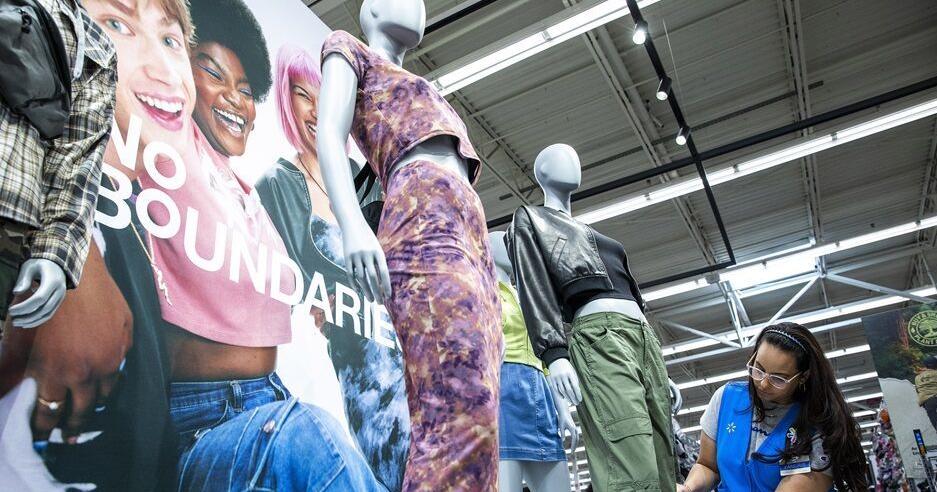NEW YORK â Walmart has spent three years overhauling its mix of adult apparel to make it stylish as well as sensible for middle America. Now, the nation’s largest retailer is seizing the back-to-school shopping season to take another shot at fashion respectability.
The company relaunched its 30-year-old brand for teenagers and young adults Tuesday with a new 130-piece fall collection aimed at Generation Z. The retooling of the No Boundaries label is part of a strategy to get customers to think of Walmart as a place to buy cool clothes along with groceries.
People are also reading…
The new collection includes of-the-moment styles like baggy jeans, cropped T-shirts, faux leather corsets and bomber jackets. Most items cost $15 or less. Some pieces are made from recycled fabrics to appeal to a generation that values sustainability. The size range was expanded to run from XXS to 5X to be more inclusive.
The Bentonville, Arkansas-based company is marketing the revamped No Boundaries on TikTok, YouTube, Pinterest and the online gaming site Roblox. It plans to test new prototypes in stores located in major college towns.
The intended audience is noticing.
Za’kyra Davis checks out clothes from Walmart’s No Boundaries collection July 11 at a Walmart Superstore in Secaucus, New Jersey. Davis, who shops at chains like Rue21 and Forever 21 and gets inspired by fashion trends she sees on social media, said she has been more open to buying clothes at Walmart in the past few months.Â
âIt’s basic, but cute,â Za’Kryra Davis, 16, said while looking at the camouflage pants and denim rompers at a Walmart store in Secaucus, New Jersey, where the new No Boundaries was getting rolled out last week.
Davis, who shops at chains like Rue21 and Forever 21 and gets inspired by trends popping up on social media, said she’s been more open to buying clothes at Walmart in the past few months because she says they look more modern.
Walmart previously relied on a variety of suppliers with separate design teams to build the No Boundaries line, which focused largely on everyday basics like T-shirts and denim. The company hired a dedicated design team to create the relaunch collection, a sign of the brand’s importance to Walmart’s broader fashion strategy.
Still, winning over customers born between 1997 and 2012 will be challenging given Walmart’s heavy competition. The generation of digital natives is known to be price conscious and willing to shop around, frequenting everything from second-hand shops and ultra-fast-fashion online retailer Shein to discounters like Target, and mall-based stores like American Eagle Outfitters.
A Walmart staff member works on a display of the No Boundaries collection July 11 at a store in Secaucus, New Jersey. To boost its legitimacy as a one-stop shop for fashionistas, Walmart has added store mannequins and colorful displays of its clothing.Â
Olivia Meyer, 22, who lives in Riverview, Florida, gets inspired by trends on the internet and makes most of her fashion purchases online, typically from Amazon, to ensure quick delivery. She approved of the cargo pants and strappy tops she saw while checking out the fall No Boundaries collection on Walmart’s website.
âIâm not loyal to one place,â Meyer said. But she added, âI think Walmart has a shot at targeting Gen Z and getting our dollars.”
While Gen Z spends the least amount on fashion of any demographic cohort except the so-called Silent Generation, retailers are eager to court young consumers because they represent the future, said Neil Saunders, managing director of research firm GlobalData.
âIf you don’t capture them today, you run the risk of them going to a rival,” he said. “Traditionally, Walmart has not been appealing to this kind of younger demographic, which is why it’s trying to change.â
A customer walks by No Boundaries merchandise July 11 at a Walmart Superstore in Secaucus, New Jersey. Walmart, the nation’s largest retailer, is using the upcoming back-to-school shopping season as another opportunity to try to get taken seriously as a fashion destination.Â
Walmart said No Boundaries generates annual sales of $2 billion, but Saunders thinks the numbers have been stagnant for a few years. He said the retailer needs to overcome the perception that its fashion aspirations end at floral prints, pull-on pants and other styles more typically worn by older adults.
Walmart signaled just how much it wants to get taken seriously as a fashion destination three years ago when it hired Brandon Maxwell, an American designer who has dressed celebrities such as Lady Gaga, as the creative director for its âelevatedâ fashion brands, Free Assembly and Scoop.
In February, the company hosted social media influencers who focus on trendy but affordable style at a fashion show that featured Maxwell’s designer collection, which is sold at high-end Saks Fifth Avenue and Neiman Marcus.
âItâs always about the women in my life who define what I do, and itâs no different at Walmart,â said Maxwell, who mingled with the Walmart guests during a luncheon after the show.
To boost its legitimacy as a one-stop shop for fashionistas, Walmart has added store mannequins and colorful displays of its clothing. Under the stewardship of Denise Incandela, executive vice president of apparel and private-label brands, the company has featured more than 1,000 brands and partnered with celebrities like Sofia Vergara.
Incandela said at a recent industry conference in New York that Walmart’s scale â it operates more than 4,600 stores in the U.S. â can help drive quality and low prices. But the big growth opportunity in clothing is with the Gen Z customer who âcares about style,” she said.
âWe have created a brand that is more modern, has better quality, has silhouettes that are more relevant to the Gen Z customer,â Incandela said. âWeâre improving the shopping experience, but we have to change that perception.”
At the Walmart in Secaucus, Elizabeth Fernandez, 58, and her daughter, Destiny Fernandez, 38, said they found the women’s clothing more appealing than in the past. They were also drawn to the overhauled No Boundaries line. Their shopping cart brimmed with pants, shorts, tops and skirts drawn from throughout the store.
Elizabeth Hernandez, left, gestures towards her daughter Destiny Hernandez as they look at items from Walmart’s No Boundaries collection July 11 at a Walmart Superstore in Secaucus, New Jersey. In hopes of resonating with younger members of Generation Z, Walmart has revamped its 30-year-old brand for teenagers and young adults. Â
Citing the cropped puffer jackets and different denim washes on the racks, Destiny Fernandez judged Walmart to be on the mark in the way it had recycled and refreshed earlier trends.
âIt’s all stuff that is coming back,â she said. âSo I am going to take a look.â
Does back-to-school spending increase credit card balances?
August and September: Busy bees or dog days?
When looking at the past 10 years of retail sales data from the U.S. Census Bureau, August and September don’t seem to be especially huge for retailers. The average change from July to August since 2014 has been a tepid 1.7% increase, which is lower than the last three months of the year. And September shows an obvious decline, where spending is 6.2% lower than it is in August.
There’s at least one obvious reason September retail sales show a persistent decline; it has one fewer day than August, which reduces the opportunity to shop. In addition, September includes the Labor Day holiday, which, despite being as much of an excuse for a sale as most other holidays, isn’t usually considered one of the busiest shopping days of the year.
Store card, credit card balances don’t show back-to-school spending upticks
Looking at recent credit card balance data from Experian, which shows how much card balances shift from month to month, August and September don’t appear to be months where balances substantially increase.
Credit card balances increased an average of 0.9% during August, which is in the middle of the pack as monthly increases are concerned. And since 2019, September balances increased by an average of only 0.1% from the prior August. The usual pattern, as this data confirms, is that consumers spend January, February, and March paying down large balance increases that occur in December, with spending rising or falling modestly for the remaining eight months of the year, including back-to-school season.
Admittedly, this five-year window is a bit limited, as the pandemic resulted in temporary but drastic short-term changes in consumer behavior.
Be the first to know
Get local news delivered to your inbox!




